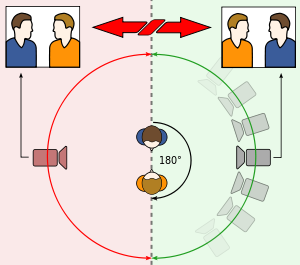Drama film editors usually reference a storyboard and a script when editing the film. Each scene usually has a purpose or message that the editing style and technique cannot distract from, hence the editing must be purposeful. During the filming of a drama film, most directors would have caught many different angles of the same conversation, and the editor would have to comb through the footage and find the reactions or expressions that best convey the message or purpose of the scene.
Shot-reverse-shot is a technique often used in the editing of a drama film to contribution to the development of tension within a conversation or a particular scene.

Flash Cutting (or Short Cuts) are used in sequences to make the duration of the clips shown very short and compact.

Seamless Editing is often used within drama films to achieve a sense of realism for the audience as they would not notice the individual cuts.

The 180 Degree Rule is often used within drama films to prevent any confusion or misunderstanding within the audience. The rule states that the camera must remain on one side of an imaginary line that is drawn perpendicular to the camera's viewpoint. Breaking this rule would confuse the audience and distract them from the narrative and plot of the film.

Match-on-Action is an editing technique used for continuity editing in which a shot is cut to another angle of the same action to create a 'visual bridge' for the audience between the two different shots. This shot cannot be confused with a graphic match, as it is portraying a continuous sense of an action.

Flash Cutting (or Short Cuts) are used in sequences to make the duration of the clips shown very short and compact.
Seamless Editing is often used within drama films to achieve a sense of realism for the audience as they would not notice the individual cuts.

The 180 Degree Rule is often used within drama films to prevent any confusion or misunderstanding within the audience. The rule states that the camera must remain on one side of an imaginary line that is drawn perpendicular to the camera's viewpoint. Breaking this rule would confuse the audience and distract them from the narrative and plot of the film.

Match-on-Action is an editing technique used for continuity editing in which a shot is cut to another angle of the same action to create a 'visual bridge' for the audience between the two different shots. This shot cannot be confused with a graphic match, as it is portraying a continuous sense of an action.

Depth of Field is the area in front of the camera that is in sharp focus. This if often important in drama films, as a manipulation in focus can be used to achieve a desired effect, for example: drawing the audience to a specific point within the scene. The Depth of Field can be either shallow or deep depending on the directors intentions. Shallow focus is the area of the frame that is out of focus or softer. Deep Depth of Field is when the entire frame - from the foreground to the background - is much sharper.



No comments:
Post a Comment